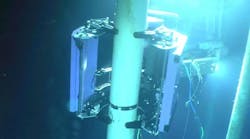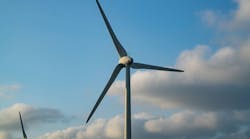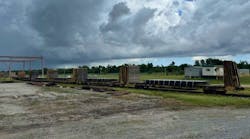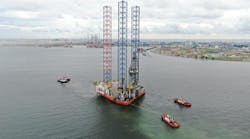Reliance due to uncertainty of western oil
Wang Ming Wu
Contributing Editor - China
Both, nearly 50 MT, have propped up the mansions of China's onshore industry. The six fields are just like a task force, if Daqing may be likened to a flagship.
Overall, it is highly important to steady oil production in East China while the replacement of oil production is difficult to get from the West dramatically during the current plan period. Whether or not Bohai Bay's yields can be leveled off has become the focus of stable yields in the East during the current plan period.
Re-appraising Bohai Bay
The Bohai Bay region is complicated. Depressions in the Bay were analyzed individually by the new and former leaders and experts of CNPC and CNOOC in January and March respectively. The year 1988, when 63.55 MT of oil were produced, some 48% of the country's total, was a record year, but production has dropped in successive years until it reached 57.74 MT in 1996 - a total decrease of 5.81 MT.Since the Hai I well drilled in 1996, Bohai Corp. has drilled 273 test wells, discovered 14 oil and gas fields and 41 oil-and gas-bearing structures, and had a 50% success ratio, higher than the international average level of 30%.
Meanwhile, Bohai has reached 2.1 MT/yr in 10 years. In incidences of less than 200 MT, oil initially in place, both foreign cooperative development and wholly owned development occurred simultaneously. Especially encouraging progress was also made in the understanding of complicated oil geology in Bohai Bay.
There are four exploration prospects from north to south in Bohai Bay:
- Liaobei oil and gas joint development system composed mainly of Jinzhou 20-2 and Jinzhou 9-3 Fields that have begun to take shape and are expected to see new development.
- Liaozhong thickened oil development system composed mainly of Suizhong 36-1, pert of which has gone onstream, with ultimate production expected to reach 4.5-5.0 MT/yr, becoming a mainstay of Bohai Corp's crude oil production.
- Large-sized Shijiutuo oil-and gas-gathering zone development system, com posed mainly of Qinhuangdao 32-6 and Nanbeo 35-2, is being appraised now and is to be further explored soon.
- Boxi-Bonan flowline network system with Qikou 10-1 and its peripheral oil and gas field group as its main body, has been selected to be the main source to supply gas to Tianjing, Of these four systems, two crude oil processing bases - Suizhong Port and Jingtang Port will be built. 4.5 MT will be reached by 2000 and 10 MT by 2005, with production capacity of 10. 5-11.5 MT - that is one MT from Jinzhou 9-3, 4.5-50 MT from Suizhong 36-1, 3.5 MT from Boxi-Bonan.
Bohai potential
As a whole, 39.5%,. of reserves in the Bohai Basin have been proven, 43% reached in Shengli and Liaohe Fields. However, over 70%, the rate of resource transformation, reached in the western countries, by comparison. Judging from this, the Bohai Sea is in low-exploration conditions, Bohai Bay has just attained middle age and has large potential.The Jiyuang depression, with the highest rate in Bohai Bay's family, can only be counted in the medium-leveled in exploration. Four gentle slopes in four main oil-generating depressions are the principal direction of exploration, and beach and shallow waters are where large- and medium-sized oil/gas fields are expected to lie, according to experts.
To sustain and stabilize development in the main oilfields, where there are high-water-bearing situations, hi-recovery-ratios, and high-recovery-rates, Shengli takes exploration as the central work and is striving for 30 MT of newly increased recoverable reserves this year, more than has ever been recovered before.
The future of the Liaohe oil field has been optimized. Being richly endowed by nature, Liaohe depression, with a huge amount of resources and high abundance is merely at the very onset of a rolling exploration as compared with Shengli and has demonstrated not only stable yields can be kept for 8-10 years but also prospective potentials. "The sun rises despite a sky with a speck of cloud", summarized former CEO of CNPC, Wang Tao.
In Dagang oil field, there are varied geological phenomena, low exploration, and enormous resources, including beach and shallow waters potential. It is provided with a material base to produce 10 MT/yr.
Huabei oil field has stepped out of an all-time valley and started rising again. Making beach and shallow waters give oil, Shengli will complete a production capacity of 3 MT, Liaohe will complete 2 MT by 2000, as will Dagang and Jidong Fields.
The over 200,000 sq km Bohai Bay sedimentary basin resulted from changes through 65 million years, and is the highest oil-and gas-gathering zone with the maximum of proven oil initially in place and the most crude oil yields in China at present. In its onshore area, large oil field discoveries-Liaohe, Dagang, Huabei, Shengli, and Zhongyuan-were made; while its offshore region, covered with water is Bohai Corp's E&D province.
Basin calculations show five onshore fields have reserves of 18.7 BT, of which 7.94 BT have been found out, 42% of total resources, and 600 MT are proven reserves approves by the State Reserve Board.
Available exploratory acreage in the Bohai Sea is 54,000 sq km corresponding to the sum of that of all onshore fields around the Bohai Sea and is similar to which in geological conditions. There is only a thin layer of water over the offshore fields.
A special fund for exploration has been increased by 20.7%. Of Shengli's total to 1.8 B, 66 exploratory wells were planned to drill in 1Q of this year, of which 27 wells have been handed over, with oil-acreage and reserves extended over nine provinces. The Haoke 1 well, a scientific survey well, is the focal point of exploration work this year. Its designed depth was deepened from 5500m to 6000m, of which 5588m were drilled as of 27 April. Oil and gas shows have been seen.
CNOOC's strategic plan
A steady-going Bohai Bay oil area should be seen against a wide background. The economic ring around Bohai Bay is one of China' s most developed areas, where only Hebei, Shandong, Liaoning, and Tianjing accounting for one-fourth of China's GNP and will become one of the fastest areas in economic growth while development of the Shengli and Liaohe oil fields have provided reliable guarantees for the petrochemical industry development and financial tax revenues in these areas.On one hand, China's oil imports will hit 50 MT by 2000, and crude oil from older offshore fields will decrease progressively during the 10th plan period; on the other hand. China National Star Petroleum Corp, founded last year, is now competing in developing offshore oil and gas resources and has appeared in the Bohai Sea. This is in line with the State Mining Administration's plans to soon enact a new policy that provides a golden opportunity and unprecedented challenges in the offshore sector.
Against that background, CNOOC has drawn up a strategic plan for reaching its second stage of development which clearly calls upon Bohai Corp to replace previous eastern operators and become a main base of crude oil production. Reserves of up to 10 MT have been discovered, from which Bohai Corp will produce 8.24 MT by 2010, 10 MT from Bohai Bay is not a dream.
Developing Suizhong 36-1
Suizhong 36-I, the largest offshore discovery up to now in China, actually a large oil field complex that offers technical challenges for the next century, has been Bohai Corp's mainstay of crude oil production. Since it was developed in 1994, Suizhong 36-I covering an extended oil-bearing area of from 24 to 43.3 sq km with 120.98 MT of preliminary proven oil initially in place plus new increased 90.37MT up to 211.71 MT, was finally approved by the State Reserve Board in March 1994. 210-290 MT looks possible according to some parameters on oil initially in place, while only 9.2 MT and more of oil initially in place was put to use for the development of the experimental zone and J zone. The remainder of which abundance is lower than that in experiment zone and J zone.China's thinking about offshore oil and gas field development has been becoming increasingly mature via cooperation and from learning from foreigners to wholly owned operations. The Caofeidian 1-6, for example, smoothly went onstream through extended testing and is a bold attempt to seek a new approach to economic and efficient offshore field development. It is the first difficult step made on a small buried hill oil pool, whereas Suizhong 36-1 is a new breakthrough in thinking about the development pattern, ocean engineering, and drilling technology:
Replacing block development with integrally developing nearly 300 MT reserves together is the direction these days. This by changing differential pressure from 2 MPa to 2.5 MPa and recovery rate from 2% to 2.5% and replacing originally assumed small single-leg or three-leg platforms with 3-6 wells with six unmanned wellhead platforms for 30 wells.
A central processing platform was not set up, but a power platform will likely be added. The vessel Mingzhu's function will be changed from processing purified oil for the experiment zone to processing water-bearing oil for the whole field.
Building a processing plant in Suizhong Port with a processing capacity of 6.5 MT water-bearing oil/yr connected which to the field by a 20-km pipeline through medium-and small-scale oil-bearing structures in Liaoxi depression that can spur vast stretches of Liaoxi and Liaozhong depressions going on-line development together. Because the mid-southern zone in Liaodong Bay covers an exploration area of 9000 sq km, of which the central and the southern Liaoxi depression has a source rock 760m thick with 4.2 BT hydrocarbon and 21 traps discovered with total resources of 540 MT.
Liaoxi depression is exactly a extension of the western depression in Liaohe Field, where 1.2 BT reserves has been found out, while the southern Liaozhong depression with 3 BT hydrocarbon has total resources of over 300 MT that is the most promising reserve zone. So the Chinese and foreign experts unanimously held that once overall exploration is launched in Liaoxi depression, the third peak period of growth in reserves-in the Bohai Sea will be realized.
Wellhead spacing to be shortened from 2m to 1.5m so as to increase wells being drilled from 16 to 30 and more after the drilling rig taking its place and use a technology in pipe-column-setting and multi-layer-sandproof at a time and in pumping-injection in the same well being possible of tertiary process, that can reduce cost by 38% and 70% respectively.
Oil sale using new built single-point transport outward on the spot 2000m off in 14 m of water can save 70 M compared with building a wharf.
The designing standard to be appropriately lowered and homemade equipment and materials to be used to the maximum. A 19.8% profit rate can be made due to drastically reduced cost even if the most abundant experiment zone is set aside. Average cost/MT production capacity including the experiment zone and J zone is expected to be US $ 180-190 M, far lower than the international and domestic levels of US $ 300 M. Seven platforms are drilling or carrying the well to completion; four oil and gas fields including Suizhong 36-1 and Chengbei are being rushed into production; while extended testing has been begun in Qinhuangdao 32-6; Boxi Field group construction and Suizhong 36-IJ zone development have entered into a critical stage. Bohai Bay is boiling with activity.
Copyright 1997 Oil & Gas Journal. All Rights Reserved.




